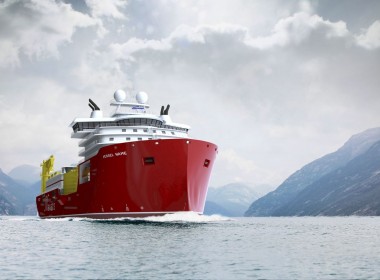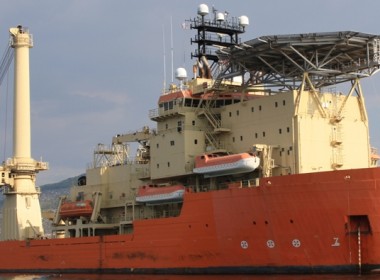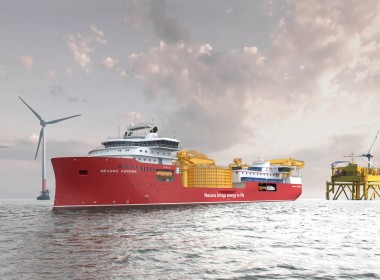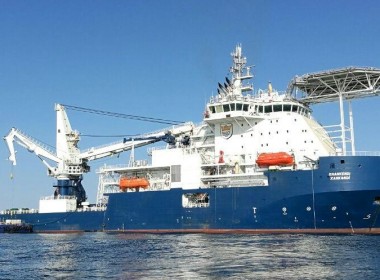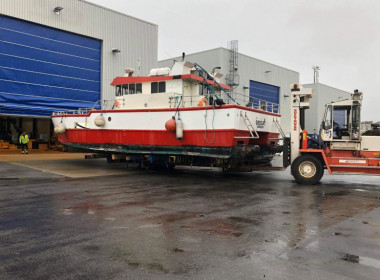VESSEL REVIEW | Nexans Aurora – DP3-equipped, cable-lay and subsea construction workhorse

Nexans has taken delivery of its newest cable-laying vessel, Nexans Aurora, following its construction at a shipyard in Norway.
The Skipsteknisk-designed newbuild has an LOA of 149 metres, a beam of 31 metres, a draught of 6.8 metres, and a summer deadweight of approximately 17,000 tonnes. The vessel can sail at a cruising speed of just under 13 knots and a maximum speed of 15 knots thanks to a propulsion arrangement consisting of six Bergen engines, ABB electric motors, and Brunvoll main thrusters. The engines each produce 3,600 kW and are compliant to IMO Tier III emissions standards.
The vessel is fitted with a DP3 system and will be used in the transport and installation of subsea high-voltage cable systems as well as a variety of other subsea construction tasks. A set of Brunvoll manoeuvring thrusters is connected to the DP3 system to provide enhanced station keeping even under challenging offshore conditions.
Nexans Aurora was designed specifically for the transport and installation of subsea high voltage cable systems, though it can also perform a variety of other subsea construction tasks as needed.
The vessel has been fitted with purpose-designed equipment for cable and umbilical transport and laying, including bundle laying, protection and jointing. Vertical lay operations and more complex subsea construction work can be effectively carried out in deep waters. The cable-laying equipment was supplied by MAATS.
A large capacity cable-handling spread includes a 10,000-tonne split turntable with dual product lay lines with features optimised for the safe and efficient handling of the full range of submarine cable systems in Nexans’ product line.
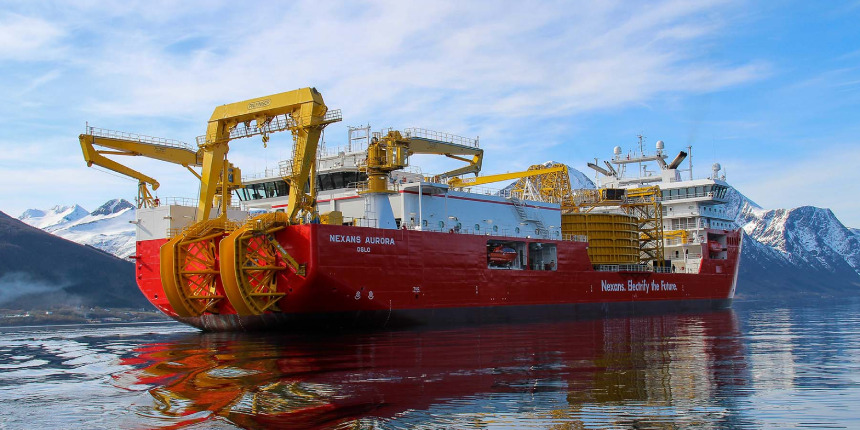
The vessel also contains a dedicated enclosed cable splicing area. This provides a controlled onboard environment for the execution of all product splicing and termination work to the exact standard as performed in the owner’s factories. Redundancy was also considered in the design of the vessel and in all onboard workspaces and equipment to ensure continued uptime regardless of the conditions in the area of operation.
A high-efficiency generator set powered by low-sulphur fuel provides power for the vessel’s comprehensive suite of cable-laying equipment. Energy is also recovered from cable lay braking while shore power connections are available for use during pier-side cable loading operations.
Nexans Aurora was designed to be as self-contained as possible. Attributes toward this goal include a long operating range and operations of extended duration even without resupply. The vessel design also offers separation of work and living areas to enhance the occupants’ comfort. To further ensure comfort, all onboard cabins are single-berth cabins.
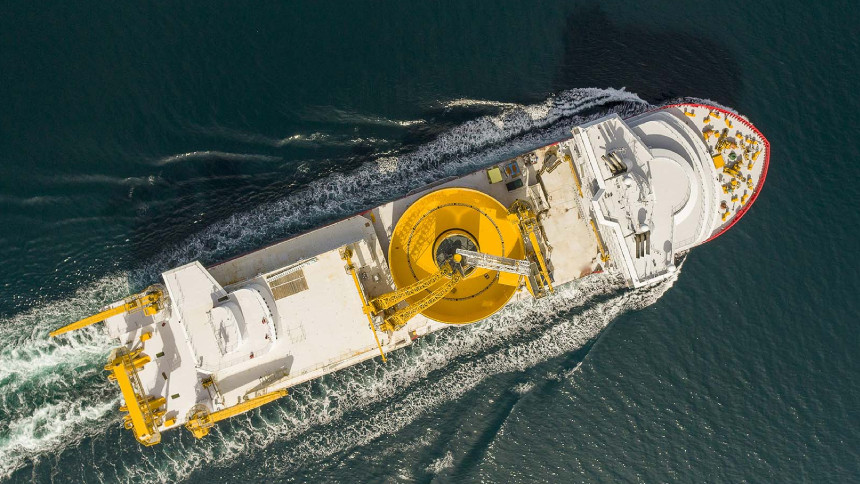
The vessel also has a passenger-only lift supplied by Lift Emotion Offshore and Industry, while the cargo lifts and the hydraulic hatches were provided by MacGregor. Kongsberg Maritime supplied a comprehensive suite of navigation and communication electronics including their corresponding bridge consoles as well as the launch and recovery systems (LARS) and umbilical and control systems for the work-class remotely operated vehicles (ROVs) used by the vessel to support its subsea installation operations.
While the vessel is at berth, the onboard electrical systems draw power from a Pon Power harbour generator set with a rated output of 1,432 kW. A Nogva Motorfabrikk emergency generator and an Ulmatec Pyro heat recovery system are available as well.
For emergencies, the crew have access to lifeboats from Fassmer and Palfinger Marine as well as a Survitec water mist firefighting installation. Small work boats built by Maritime Partner are also embarked to serve as tenders. Launching and recovery of the smaller craft is done with the aid of dedicated davits.

For more news, opinion and vessel reviews as part of this month’s Offshore Week, click here.
| Nexans Aurora | |
| SPECIFICATIONS | |
| Type of vessel: | Cable-laying vessel |
| Flag: | Norway |
| Owner: | Nexans, France |
| Operator: | Nexans, France |
| Designer: | Skipsteknisk, Norway |
| Length overall: | 149 metres |
| Beam: | 31 metres |
| Draught: | 6.8 metres |
| Deadweight tonnage: | 17,000 |
| Capacity: | ROVs; 10,000 tonnes |
| Main engines: | 6 x Bergen, each 3,600 kW |
| Propulsion: | Brunvoll |
| Auxiliary engines: | ABB |
| Generators: | Nogva Motorfabrikk; Pon Power, 1,432 kW |
| Side thrusters: | Brunvoll |
| Maximum speed: | 15 knots |
| Cruising speed: | 13 knots |
| Dynamic positioning: | Kongsberg Maritime DP3 |
| Other electronics: | Blue Ctrl IAS; Kongsberg Maritime bridge consoles; ABB switchboards |
| Cranes: | Red Rock Marine |
| Other deck equipment: | MAATS turntable; MAATS cable lay lines; MacGregor hydraulic hatches; Kongsberg Maritime hangar doors; Kongsberg Maritime ROV LARS; Kongsberg Maritime ROV umbilical control systems; Vestdavit lifeboat davits; Palfinger Marine lifeboat davits; Vestdavit workboat LARS; Red Rock Marine cherry picker |
| Other equipment installed: | Lift Emotion C-line passenger lift; MacGregor Sweden cargo lift; Ulmatec Pyro heat recovery system; Ulmatec Pyro boilers; IMS watertight doors; Libra Plast external doors; AF Aeron Moillier HVAC; Jets sanitary discharge systems; Hydroniq Coolers; Allweiler pumps; Norwegian Greentech ballast water treatment system; Ulmatec Baro fairing |
| Paints: | Jotun |
| Interior fitout/furnishings: | Enclosed cable splicing area; ROV hangars; Rovde Mobel and Design furniture |
| Firefighting equipment: | Survitec water mist system |
| Lifeboats: | Fassmer; Palfinger Marine |
| Tenders: | Maritime Partner |
| Type of fuel: | Diesel |
| Accommodation: | Single cabins |




